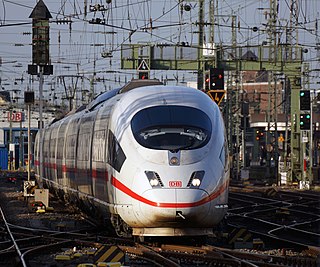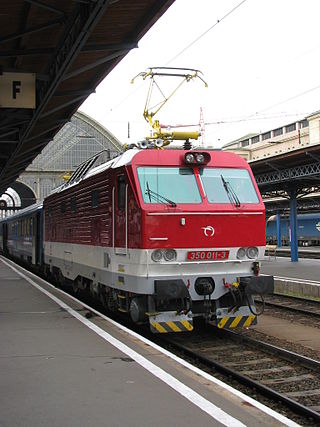
As of 2021, Germany had a railway network of 33,399 kilometres (20,753 mi), of which 20,540 kilometres (12,760 mi) were electrified and 18,556 kilometres (11,530 mi) were double track. Germany is a member of the International Union of Railways (UIC). The UIC Country Code for Germany is 80.

InterCity is the classification applied to certain long-distance passenger train services in Europe. Such trains generally call at major stations only.

The Polish State Railways is the dominant railway operator in Poland. The company was founded when the former Polish State Railways state-owned enterprise was divided into several units based on the need for separation between infrastructure management and transport operations. Polish State Railways is the dominant company in PKP Group collective that resulted from the split, and maintains in 100% share control, being fully responsible for the assets of all of the other PKP Group component companies. The group's organisations are dependent upon Polish State Railways, but proposals for privatisation have been made.

The Trans Europ Express, or Trans-Europe Express (TEE), was an international first-class railway service in western and central Europe that was founded in 1957 and ceased in 1995. At the height of its operations, in 1974, the TEE network comprised 45 trains, connecting 130 different cities, from Spain in the west to Austria in the east, and from Denmark to Southern Italy.

In the summer of 1939, weeks ahead of the Nazi German and Soviet invasion of Poland the map of both Europe and Poland looked very different from today. The railway network of interwar Poland had little in common with the postwar reality of dramatically changing borders and political domination of the Soviet-style communism, as well as the pre-independence German, Austrian and Russian networks which the Second Polish Republic had partially inherited in 1918 after the end of World War I. The most important junctions in the Polish territory in summer of 1939 were:

The Polish railways network consists of around 18,510 kilometres (11,500 mi) of track as of 2019, of which 11,998 km (7,455 mi) is electrified. The national electrification system runs at 3 kV DC.

The Děčín–Dresden railway, also called the Elbe Valley Railway is an electrified main line in Saxony and the Czech Republic. Formerly called the Saxon-Bohemian State Railway, the line is part of the Dresden to Prague route and is one of Europe's most important trunk routes (Magistralen). It runs along the Elbe Valley from Děčín via Bad Schandau and Pirna to Dresden. The first section of the line was opened in 1848 and is one of the oldest lines in Germany.
High-speed rail service commenced in Poland on 14 December 2014, with the introduction of 20 non-tilting Pendolino trainsets operating on 4 designated lines radiating out from Warsaw. Polish State Railways started passenger service trains PKP Pendolino operating a speed 200 km/h on 80 km line Olszamowice-Zawiercie. From December 2017 there are two 200 km/h sections, 136 km long in total. Polish state railways PKP launched the high-speed service under the Express Intercity Premium (EIP) brand name.

The Balkan Express was an international overnight passenger train that ran between Istanbul, Turkey and Belgrade, Serbia, via Sofia, Bulgaria. The train began operations in 1991 from Istanbul to Budapest, Hungary, but was cut back to Belgrade after 2000. Service was discontinued in March 2013, when Sirkeci station closed for the construction of the Marmaray commuter rail network. In 2017, the Istanbul-Sofia Express was inaugurated as a successor to the Balkan Express, although the route was shortened to Sofia.

Rail transport in the Czech Republic carried 193.5 million passengers in 2019, and 68.37 million tonnes of cargo in the year 2009. The majority of passenger services run nowadays are operated by the state company České dráhy, which until 2007 also managed cargo services now run by ČD Cargo. In 2009 the country had 9,420 km of standard gauge track, 3,153 km of which is electrified. There are two main electrification systems in the Czech Republic, 3 kV DC in the northern part, and 25 kV 50 Hz AC in the south. Locomotives had to be changed on boundaries in the past, two-system locomotives have been introduced in 1974. The network has same gauge links to all four countries bordering the Czech Republic with passenger services to all four countries in operation. Major hubs for international passenger services on the network are in Prague, Ostrava, Brno and Břeclav, and the busiest station is Praha hlavní nádraží. Maximum speed on Czech rails is 160 km/h (99mph).

Hungaria is a EuroCity train which runs between Budapest Nyugati and Hamburg - Altona, currently running with coaches of MÁV. It is numbered as EC 252-253 and runs daily, mainly with MÁV owned rolling stocks.
Interexpress is a former international train category. The word Interexpress is a short form version of the German language term Internationaler Express and its foreign language equivalents.

Berolina was a named passenger train between Warsaw and Berlin via Frankfurt (Oder). Introduced in 1959, it went through a number of iterations, including a short period without a name. Part of the Interexpress network as IEx 242/243 from 1986, it became categorised as EuroCity trains 42 and 43 in 1992. The service was finally replaced by the Berlin-Warszawa-Express in 2002.
The Primator was an international express train. Introduced in 1986, it ran between Prague, then the capital of Czechoslovakia, and East Berlin, then the capital of the German Democratic Republic (GDR).
The Porta Bohemica is a EuroCity (EC) international express train. Since December 2014 it is operating between Hamburg-Altona and Budapest Keleti.
The Comenius has been the name of two distinct EuroCity (EC) international express trains, both of them originating, terminating or passing through Prague, the capital of the Czech Republic.

The Praha is a EuroCity international express train. Introduced in 1993, it runs between Warsaw, the capital of Poland, and Prague, the capital of the Czech Republic. The train's name, Praha, is the Czech word for Prague.

The Sobieski is a EuroCity (EC) international express train. Introduced in 1994, it runs between Vienna, the capital of Austria, and Warsaw, the capital of Poland, via the Czech Republic.

The Polonia is a EuroCity (EC) express train. It was introduced in 1997, to supplement the existing EuroCity train, the Sobieski, on the international route between Vienna, the capital of Austria, and Warsaw, the capital of Poland, via the Czech Republic.

Wawel is a named international express train. Introduced in 1995 as an InterCity service, it was upgraded to EuroCity category by its operators PKP Intercity and DB Fernverkehr in 2006. The service was withdrawn at the end of 2014 but reintroduced in December 2020.















